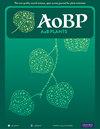Leaf habit and plant architecture integrate whole-plant economics and contextualize trait-climate associations within ecologically diverse genus Rhododendron
IF 2.4
3区 生物学
Q2 ECOLOGY
引用次数: 0
Abstract
Summary Rationale Plant resource strategies negotiate a trade-off between fast growth and stress resistance, characterized by specific leaf area (SLA). How SLA relates to leaf structure and function, or plant climate associations remains open for debate, and leaf habit and plant architecture may alter the costs versus benefits of individual traits. Methods We used Phylogenetic Canonical Correspondence analysis and Phylogenetic Least Squares to understand the relationship of anatomy and gas exchange to published data on root, wood, architectural and leaf economics traits, and climate. Key results Leaf anatomy was structured by leaf habit and carbon to nitrogen ratio was a better predictor of gas exchange than SLA. We found significant correspondence of leaf anatomy with branch architecture and wood traits, gas exchange corresponded with climate, while leaf economics corresponded with climate, architecture, wood, and root traits. Species from the most seasonal climates had the highest trait-climate correspondence, and different aspects of economics and anatomy reflected leaf carbon uptake versus water use. Main conclusion Our study using phylogenetic comparative methods including plant architecture and leaf habit provides insight into the mechanism of whole-plant functional coordination and contextualizes individual traits in relation to climate, demonstrating the evolutionary and ecological relevance of trait-trait correlations within a genus with high biodiversity.在生态多样性的杜鹃花属中,叶片习性和植物结构整合了整株植物的经济性,并将性状与气候的关系背景化
摘要 理论依据 植物资源战略在快速生长和抗逆性之间进行权衡,具体表现为比叶面积(SLA)。SLA 与叶片结构和功能或植物气候的关系如何仍有待商榷,叶片习性和植物结构可能会改变单个性状的成本与收益。方法 我们使用系统进化卡农对应分析和系统进化最小二乘法来了解解剖学和气体交换与已发表的根、木材、建筑和叶片经济学性状以及气候数据之间的关系。主要结果 叶片解剖结构由叶片习性决定,碳氮比比 SLA 更能预测气体交换。我们发现叶片解剖与枝干结构和木材性状有明显的对应关系,气体交换与气候有对应关系,而叶片经济性与气候、结构、木材和根系性状有对应关系。气候季节性最强的物种的性状与气候的对应性最高,经济性和解剖学的不同方面反映了叶片对碳的吸收和对水的利用。主要结论 我们的研究采用了包括植物结构和叶片习性在内的系统进化比较方法,深入探讨了植物整体功能协调的机制,并将个体性状与气候联系起来,证明了生物多样性较高的植物属中性状-性状相关性在进化和生态学方面的意义。
本文章由计算机程序翻译,如有差异,请以英文原文为准。
求助全文
约1分钟内获得全文
求助全文
来源期刊

AoB Plants
PLANT SCIENCES-
CiteScore
4.80
自引率
0.00%
发文量
54
审稿时长
20 weeks
期刊介绍:
AoB PLANTS is an open-access, online journal that has been publishing peer-reviewed articles since 2010, with an emphasis on all aspects of environmental and evolutionary plant biology. Published by Oxford University Press, this journal is dedicated to rapid publication of research articles, reviews, commentaries and short communications. The taxonomic scope of the journal spans the full gamut of vascular and non-vascular plants, as well as other taxa that impact these organisms. AoB PLANTS provides a fast-track pathway for publishing high-quality research in an open-access environment, where papers are available online to anyone, anywhere free of charge.
 求助内容:
求助内容: 应助结果提醒方式:
应助结果提醒方式:


